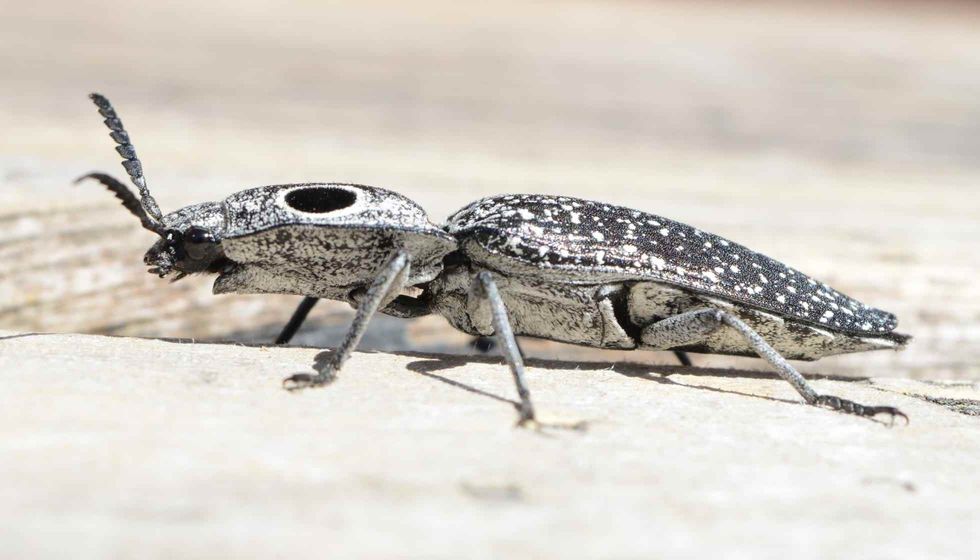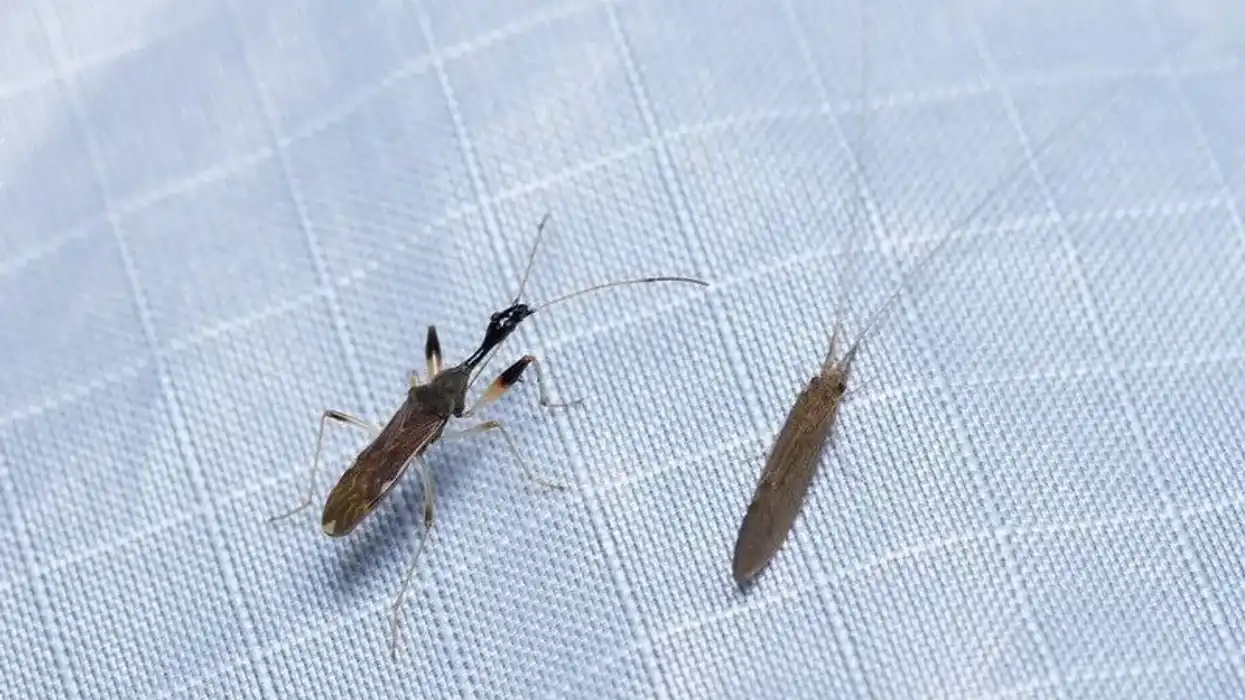The eastern-eyed click beetle (Alaus oculatus) is a species in the click beetle family and is commonly called the eyed elater or the wireworm.
The beetle has two large black eyespots on its back which is a unique feature and also something that confuses predators when attacking them.
They have a defense mechanism responsible for their common name, when disturbed the beetle launches itself in high altitudes of up to six feet to protect itself. The adult of the species eat less and are harmless to humans unless harmed in some way in which case their first reaction is to escape through flight response.
Eastern-eyed click beetle sound is well recognized and is similar to other species of click beetles, one such sound they make is when they flip themselves upright.
It gets its name from the central, North America, and east American regions where it originates. Eastern-eyed click beetle habitat is primarily with other beetles in deciduous forests and specifically in decaying woods, rotting logs, and trees since that is where their basic needs are met, food and shelter.
They might be seen in different areas as well. If you liked this article please visit atlas beetle and Christmas beetle.
Eastern Eyed Click Beetle Interesting Facts
What type of animal is an Eastern-eyed click beetle?
The eastern-eyed click beetle is a type of insect animal and this species belongs to the family Elateridae or click beetles. All species in this family have a similar name.
What class of animal does an Eastern-eyed click beetle belong to?
The eastern-eyed click beetle is an arthropod and is one of the largest known click beetles in the family Elateridae.
How many Eastern-eyed click beetles are there in the world?
The eastern eyed click beetle distribution is not evaluated by the IUCN, the exact population of the insect species is unknown. However, here's an interesting fact for you, there are 3,50,000 species of beetles and hence they are known as the largest group of animals on earth.
Where does an Eastern eyed click beetle live?
This species is present in Central, Eastern, and North America, and in specific the insect is found in deciduous forests like woods, or in the soil as well. They are considered a pest by many since they feed on insects and may feed on the roots of plants as well in some instances hence its name 'wireworm'.
Weeds are especially susceptible to wireworm damage.
What is an Eastern eyed click beetle's habitat?
They primarily reside in deciduous forests where there is decaying wood and trees. The Alaus oculatus is unique among wireworms since they are predatory to other beetle larvae.
They feed in insects seen in these decaying woods or logs and inflict most of their damage in the early spring on crops and other insects in the soil. When in the soil they are primarily able to seek shelter and also able to find appropriate food options.
Who do Eastern eyed click beetles live with?
The eastern-eyed click beetle lives on its own, in the deciduous forests or in soil. Eastern-eyed click beetle bite into the crop and weeds in the fields.
If you find lots of them and want to protect your crops or weeds it's best to install pest control however if you find them in your gardens or other ecological spaces it's best to gently pick them up and take them away from the area.
How long does an Eastern eyed click beetle live?
The eastern-eyed click beetle may live from two to five years depending on its environment, dietary patterns, and other elements. The oldest living beetle species are the splendour beetles some of which remain in the larvae stage for more than 30 years. Eastern-eyed click beetle larvae have a relatively shorter lifespan including its years as an adult.
How do they reproduce?
Beetles primarily lay eggs and give birth to slow-growing larvae also referred to as wireworms. These larvae pupate in rotting logs or below the ground. The beetles emerge in the spring to reproduce and are found until September.
This is also the time when they require the most nutritional requirements. The larva feeds on insects and consumes more than adult beetles.
The larvae then grow in decaying plants and go through the different stages and finally become adult beetles. The adult beetle is appealing in appearance compared to when it is in its larvae stage. Adults grow up to one inch long and larvae are up to two-inch-long in size.
What is their conservation status?
The eastern-eyed click beetle conservation status is not evaluated by the IUCN. The fact that the eastern-eyed click beetle dangerous or not is quite confusing since they are considered pests in many instances, however they don't harm humans unless harmed.
To avoid crop or weed destruction is essential to install adequate pesticides and other measures to reduce their presence in the fields.
Eastern Eyed Click Beetle Fun Facts
What do eastern eyed click beetles look like?
The eastern-eyed click beetle anatomy consists of an exoskeleton, they don't have internal skeletons as humans, and they have wings which helps them fly. Wireworms have a slender, long, and cylindrical shape.
It looks similar to its relative called the southwestern-eyed click beetle and other cousins in the Pacific Northwest and the West coast.
The eastern black-eyed click beetle has other colors including white and gray on its body as well. An easy for you to identify them is to look out for its large eyespots on its back which it uses to mesmerize and distract predators.
How cute are they?
The eastern-eyed click beetle is extremely cute and unique in its appearance as compared to other species of beetles and their distinguishing feature is its two large black eyespots which are seen on its pronotum making it firstly, easier to identify; secondly, its unique in appeal and so effective in confusing possible predators from attacking them.
How do they communicate?
Click beetles, specifically adults, are known for the sound they make when they flip themselves upright. They make a loud noise when it snaps a spine under its thorax propelling the beetle into the air which helps it turn back.
Apart from this they, too, have various sign communications and vibrations which they make within similar species. Adult beetles usually locate females by their scent during mating season. These are not audible like other species of animals however they are equally effective.
How big is an Eastern eyed click beetle?
Eastern-eyed click beetle is one inch long in size which is double the size of smaller click beetles are which is usually 0.25 in long. The largest species of beetles is the O. Macronatus.
How fast can an Eastern eyed click beetle run?
Adults have good speed and in many instances because of its speed it might appear as a blur to the human eye, however, when in a position of threat they choose the flight response. The eyed elater can fly up to six feet above ground level.
How much does an Eastern eyed click beetle weigh?
Eastern-eyed click beetle (Alaus oculatu) or the eyed elater weights up to 22.7 g which is 0.8 oz.
What are their male and female names of the species?
Alaus oculatus male and female are not addressed differently, however they do have differences in outer appearance which you can spot with a keen eye. Male antennae are longer than the pronotum length and less pectinate. Also, adult males are slightly brighter in color as compared to female click beetles.
What would you call a baby Eastern eyed click beetle?
A baby eastern-eyed click beetle is referred to as an egg initially and once it hatches from the egg it is referred to as larvae. The larvae is about two-inch long and after some time they group to develop wings and a hard exoskeleton that protects them. Adult eastern-eyed click beetles are one inch long.
What do they eat?
They eat smaller insects seen in decaying woods and also feed on larvae of wood-boring beetles. Eastern-eyed click beetle larvae feed more on insect meed available as compared to adults who eat less. Since they also feed on insects and sometimes crops and weeds it's essential to install proper pest control.
Are they poisonous?
They need to be handles carefully since they are wild beetles and can use their sharp bite if not handled carefully. As long as they are not harmed you can observe them from an appropriate distance in deciduous forests or decaying woods.
Would they make a good pet?
They are innately wild insects and hence they are best observed out in their natural habitat. Keeping them as a pet is not a good idea since they have the possibility to bite if not handled properly and another crucial reason is their survival.
There are certain insects like stick insects, millipedes, cockroaches and certain species of scorpions that can be kept as pets.
Did you know...
Few of the 800 or so species of click beetles are found in North America. This is despite the fact that beetles live in nearly every habitat and 30,000 of them live in North America itself.
Adults although do not eat much and in many instances feed on nectar. They are attracted to light and heat, hence if they don't find a suitable place to go they might enter houses through opened window or doors at night.
There are probably 10 million species of insects alive on earth today and they probably constitute more than 90 per cent of all animal species.
How does an Eastern eyed click beetle protect itself?
One of the primary protection instincts that the eastern click beetle has is its large eyespots that make predators think the rest of their body is proportional and avoid attack since predators only attack prey when they are distracted.
Another way they protect themselves is through their flight instinct since they have two wings, else they burry themselves in soil or near cultivated regions where crops exist.
What trees are Eastern eyed click beetles commonly found on?
Eastern eyed click beetles are found in deciduous forests or in decaying log of wood where other small insects resides. They reside in prune trees primarily for food and shelter.
Apart from this since they fly they might be found in other territories as well. They are often confused with other species of animals who look similar to them and hence its essential to keep a keen eye to spot such unique insects.
Here at Kidadl, we have carefully created lots of interesting family-friendly animal facts for everyone to discover! Learn more about some other arthropods including puss moth, or green stink bug.
You can even occupy yourself at home by drawing one on our Eastern eyed click beetle coloring pages.










